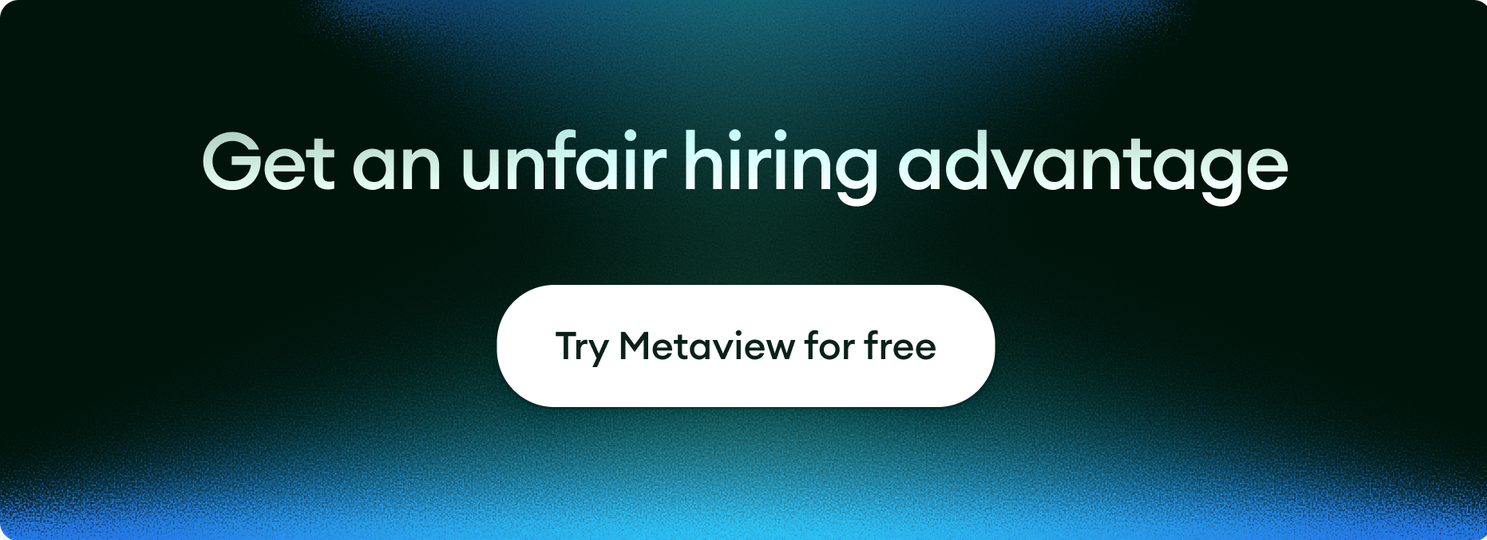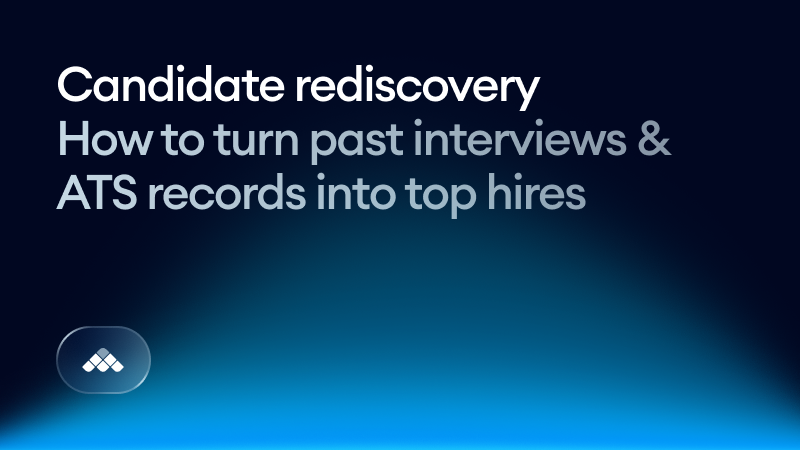Sourcing is most commonly associated with net-new prospects. New searches, new outreach, new lists, and new profiles, all to build new pipelines.
But what if some of your best future hires are already in your ATS? What if previous interviews, past silver medalists, and warm but paused candidates could resurface exactly the people you’re looking for today?
That’s the power of candidate rediscovery. And for companies that care about quality at scale, it’s one of the most valuable sourcing strategies they have.
In this guide, we break down what candidate rediscovery is, why it’s so impactful, and how AI makes it finally scalable. Because why start every search from scratch, when you may already have the perfect person waiting for your call?
Key takeaways
- Candidate rediscovery improves quality and speed simultaneously, giving you an advantage in competitive markets.
- Your ATS is one of your most valuable sourcing channels, provided you know how to unlock it.
- AI makes rediscovery scalable, by connecting historical interview data with modern hiring needs in seconds.
What is candidate rediscovery?
Candidate rediscovery is the process of resurfacing and re-engaging past applicants or previously-interviewed candidates when new roles open. Instead of starting every search from zero, you draw on the rich history already stored in your ATS.
You already have a contact list full of people who expressed interest before, got deep into the process, and nearly made the cut.
In other words, it’s sourcing from your own pipeline, instead of creating a whole new one every time. And for recruiting teams that value smart work over hard work, it’s a no-brainer.
Why candidate rediscovery is so valuable
Candidate rediscovery isn’t some sourcing hack. By tapping into candidates your team has already evaluated, engaged, and invested time in, you immediately unlock a pool of high-signal talent that’s faster and more reliable to hire from than starting fresh.
Candidate rediscovery helps recruiters:
- Accelerate time to fill by skipping early-stage screening
- Increase quality of hire because candidates have already been evaluated
- Improve candidate experience, especially for silver medalists
- Lower cost per hire, since much of the work was done previously
- Build long-term, relationship-driven hiring pipelines
Most importantly, you capitalize on the investment you’ve already made. Every interview you’ve run contains valuable signal. Candidate rediscovery ensures that signal doesn’t go to waste.
What you need to make candidate rediscovery viable
Candidate rediscovery relies on underlying data and systems to make it possible. Here’s what’s required to turn it into a repeatable, high-impact sourcing motion.
1. Well-structured interview records
Rediscovery is only as good as the data behind it. If interview notes are sparse, unstructured, or missing entirely, then searching past candidates becomes unreliable.
High-quality rediscovery requires:
- Competency-based scorecards
- Standardized interview formats
- Detailed notes tied to behavioral evidence
- Clear explanations for pass/no-pass decisions
- Interview transcripts or summaries
The goal is to quickly and accurately match past candidates with newly-opened roles. That’s only possible where you have well-designed interview notes and scorecards to refer back to.
2. Integrated ATS and interviewing tools
Those interview notes above also need to be featured in your other core recruiting systems. If you rely on platforms like Ashby or Greenhouse as your TA source of truth, it’s no good to have your takeaways from key calls in some disconnected tool.
To be viable, you need:
- Interview data automatically integrated into the ATS
- Feedback, transcripts, and scorecards attached to profiles
- No manual copy-pasting across tools
- Version history for roles and candidate decisions
You want your ATS to be a complete and detailed record of each applicant, not just a vague sketch.
3. Searchable, structured candidate profiles
The operational aspect of rediscovery is also important. You can keep the most incredible records, but if they’re hard to access, you’ll never use them. Recruiters need to search past candidates using real, performance-linked data and insights.
This means:
- Skills and competencies tagged and indexed
- Strengths, weaknesses, and behavioral signals extracted from interviews
- Notes searchable by intent, not just exact language
- The ability to filter by interview stage, performance, or role similarity
The more structured and searchable your candidate profiles are, the more rediscovery becomes a superpower.
4. A team that treats rediscovery as a first-class sourcing channel
Even with perfect data, rediscovery only works if your team uses it. And in particular, it demands that you view previously-considered candidates as just as valid and exciting (if not more so) than net new prospects.
That requires:
- Searching the ATS before going outbound
- Reviewing silver medalists during kickoff calls
- Re-engaging warm candidates before launching sourcing campaigns
- Setting rediscovery KPIs or SLAs for recruiting teams
Rediscovery isn’t a backup plan; it should be the first step in every search.
How to do candidate rediscovery in 6 steps
Candidate rediscovery works best when it’s part of a clear, repeatable workflow. Instead of relying on memory or ad-hoc searches, teams need a structured process that consistently surfaces the strongest past candidates for every new role.
These six steps provide a practical, scalable way to make rediscovery a core part of your sourcing strategy.
1. Start every search in your ATS
Before launching into new sourcing, begin by exploring the talent you’ve already met. These candidates have expressed interest, gone through evaluation, and built familiarity with your company, making them far more efficient to re-engage than starting cold.
Treat the ATS not as archival storage, but as your first and most valuable sourcing channel. Before opening LinkedIn or building a new search string, run a rediscovery sweep:
- Filter by similar past roles
- Pull up previous shortlists
- Look at past finalists and silver medalists
- Review past referrals
You may easily find that a significant percentage of new roles can be filled from rediscovery alone.
2. Reassess the role’s competencies and map them to past candidates
Every role evolves, and what mattered six months ago may not matter today. That’s why rediscovery works best when you align current role requirements with the historical strengths revealed in past interviews.
By remapping competencies, you can spot candidates who may now be a perfect fit. Even if they were a near miss previously.
Ask:
- What are this role’s must-have competencies?
- Who in the ATS demonstrated those competencies in previous interviews?
- Did any silver medalists excel in these areas but miss on others now less relevant?
As long as your impressions and competencies tags are well maintained, this step should be easy.
3. Re-read past interview summaries and feedback
This is where structured data pays off. The real power of rediscovery comes from revisiting the rich insights captured during prior interviews.
Instead of relying on vague recollections, returning to structured notes or summaries helps you identify strengths, behaviors, and potential that may have been overlooked for different roles.
Look for:
- Strengths aligned to new priorities
- Growth potential since the last interview
- Interviewer comments signaling future fit
- Reasons for rejection that may no longer matter (timing, role mismatch, market conditions)
You should always strive to do this work based on real evidence, and not simply rely on memory.
4. Build a shortlist and re-qualify the candidates
Once you’ve identified promising past candidates, the next step is to validate whether they’re still aligned, available, and interested. Re-qualification ensures your shortlist contains high-intent, high-fit prospects before you invest deeper time.
This also gives you an opportunity to personalize outreach based on your shared history.
Reach out to 5-10 rediscovered candidates with:
- Personalized context (“We interviewed you last year for X…”)
- Updates about the team or company (and what’s changed in their favor)
- Why you believe they may now be a fit
- An invitation to reconnect
These candidates already know your brand. Sincere, warm re-engagement makes a big difference.
5. Present rediscovered candidates early to hiring managers
Hiring managers appreciate momentum, and rediscovered candidates create an immediate sense of progress. Bringing them forward early demonstrates strategic thinking, because these candidates already come with context and performance signals.
It also helps you align quickly on what good looks like before investing in fresh sourcing.
Present rediscovered candidates alongside:
- Their past interview performance
- What has changed in the role
- Why they may now be a better match
- What you want to validate in the next conversation
This builds trust with hiring managers, and shows how deeply you’ve considered their needs.
6: Keep rediscovered candidates warm going forward
Rediscovery compounds in value when candidates remain engaged over the long term. Even if someone isn’t the right fit today, a light-touch nurturing approach can keep them excited about future opportunities.
By maintaining warmth, you create a self-renewing pipeline that gets stronger with every search. And a rich, positive hiring pool is a major plus in the long run.
Why AI and automation are critical for candidate rediscovery
Manual rediscovery simply doesn’t scale. Perhaps a diligent, caring recruiter can keep a handful of near-hires in mind. You might get lucky and the perfect role opens up to suit one or two of your recent favorites.
But that will never work for dozens of open roles. And you still need strong evidence of their skills and fit for the company.
Recruiters don’t have the bandwidth to review hundreds of profiles, analyze old notes, or re-evaluate competencies by hand. Here’s how the right AI hiring tools can mean you never need to.
AI can interpret interview signals at depth
Modern AI recruiting assistants can:
- Read full transcripts
- Extract competencies
- Identify strengths and gaps
- Summarize past performance
- Compare candidates to new role requirements
This gives you instant understanding of a candidate’s historical performance. It’s fast and incredibly accurate, no matter the number of roles or profiles involved.
AI can match candidates to new roles instantly
Instead of merely matching keywords, AI uses far more complex context and insights to pluck out the best fits in your pipeline. These include:
- Skill adjacency
- Behavioral evidence
- Competency overlap
- Similarity scoring
- Hiring manager preferences
Every past candidate is rediscoverable—not just the few you happen to remember.
How Metaview powers rediscovery
Metaview’s AI captures and structures every interview, so you have the depth and detailed insights you need for every past and future candidate.
When a new role opens, the AI Sourcing agents build a pipeline of interesting, talented candidates from millions of sources online. But crucially, thanks to native ATS integrations, the same agents look for existing profiles who’ve already been interviewed, assessed, and potentially validated.
Metaview automatically surfaces candidates who demonstrated relevant competencies, even if the interview took place years ago. You can easily compare them against any net new candidates, with the specific feedback and go/no-go decisions that were made last time you met them.
It’s the single best way to build a sourcing process that’s both forward-looking and makes use of previous interactions. All with no extra effort from recruiters or hiring managers.

Bring past candidates back to the fore today
Building a world-class hiring pipeline doesn’t always require starting from scratch. Candidate rediscovery gives you a scalable, efficient way to tap into proven talent, reduce sourcing waste, and keep quality high even as hiring needs shift.
Your ATS is one of your most powerful sourcing channels, but only if you unlock it. Candidate rediscovery helps teams:
- Move faster
- Hire more accurately
- Reduce sourcing burden
- Re-engage candidates who already know and trust your company
And with Metaview, rediscovery becomes automated and effortless. You get high-fit candidates before your outbound search even begins. Give it a try and bring your best
Start rediscovering today. Try Metaview for free.
Candidate rediscovery FAQ
Does rediscovery replace traditional sourcing?
No, it complements it. Rediscovery gives you high-intent candidates quickly while outbound sourcing builds new pipeline.
Why is candidate rediscovery valuable?
Because it increases quality of hire, reduces time to fill, and maximizes the value of every interview your team has already conducted.
What types of data do you need for effective rediscovery?
Structured interview notes, centralized profiles, consistent tagging, and integrated ATS + interview data.
How does AI help with candidate rediscovery?
AI can read interview transcripts, extract competencies, match candidates to new roles, and automatically surface high-fit past candidates.
Can Metaview automate rediscovery?
Yes. Metaview’s AI analyzes every interview and resurfaces past candidates precisely when they fit new role requirements.


